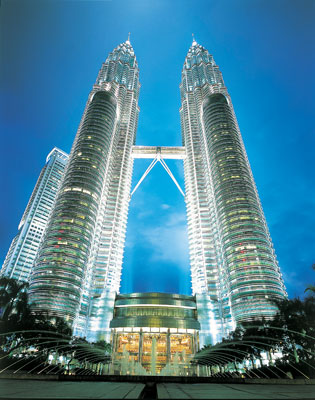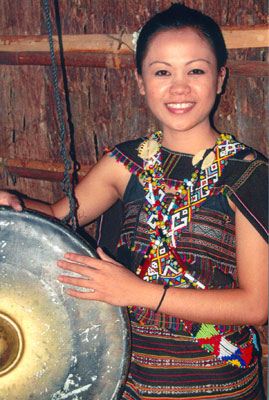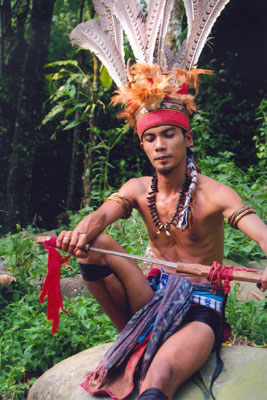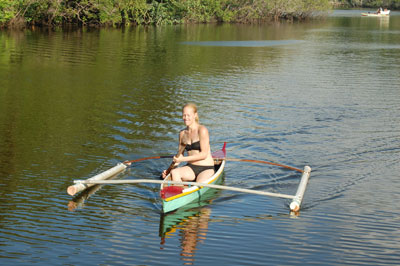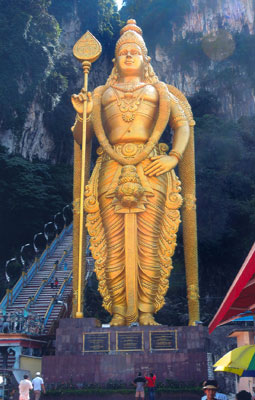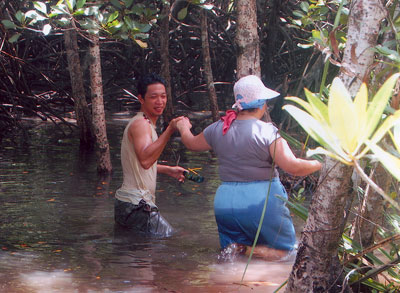Encountering caves, crafts and culture on an introductory tour of Malaysia
This article appears on page 18 of the January 2013 issue.
by Wayne Wirtanen, Contributing Editor
Nine of the 13 states of Malaysia have hereditary royal rulers. They take turns in the ceremonial role of king — with a palace and kingly perks — on a rotating 5-year cycle. An elected government takes on the heavy lifting.
This was only one of the surprises experienced on my May ’12 visit as a guest of Tourism Malaysia.
Getting acquainted
Accommodations in Malaysia seemed modestly priced. Great rooms at the Sheraton Imperial Kuala Lumpur cost around $100 per night, which included a fantastic breakfast buffet (with a generous supply of smoked salmon) and a complimentary copy of the Asian edition of The Wall Street Journal. However, the best rates require booking via the Internet.
Taxis were also relatively inexpensive.
Peninsular Malaysia is located south of Thailand, while Malaysian Borneo shares an island with Indonesia and Brunei. The two parts are separated by about 500 miles of the South China Sea. I have to confess that I had to pull out maps to find that both are south of Vietnam and the Philippines.
The sights
The capital city, Kuala Lumpur, boasts a structure every bit as iconic as the Eiffel Tower is to France. The gleaming, metal-clad Petronas Twin Towers rise 88 stories over the Kuala Lumpur city center.
Tours take visitors to the “skybridge” that connects the towers, about 557 feet above ground, as well as to the observation deck on level 86. Tickets cost MYR80 ($26), but they are limited, so I suggest getting in line for them (in the building’s basement) early in the day.
During a visit to the Royal Selangor Pewter Visitor Centre, we enrolled in the company’s tourist-participation program (MYR60, or $19.50, per person). Along with aprons sporting the “School of Hard Knocks” logo, we were provided with a 5-inch-wide disk of thin pewter and encouraged to transform it into a small bowl by hammering it into shape using progressively deeper wooden molds. A half hour of vigorous hammering, with an appropriate level of noise, produced take-home pewter dishes with our initials stamped proudly on the bottoms.
Religious sites
Just eight miles north of the capital, the Batu Cave complex is a limestone cliff that is home to not only a colony of bats but a major Hindu site — not to mention swarms of monkeys scurrying up and down the 272 steps to the Temple Cave.
At the base of the cave area stands what I think is the most spectacular statue I have ever seen. A 140-foot-high, gold-leaf-covered image of the Hindu god Murugan, brilliantly aglow in the sunshine, towered over the area, dwarfed only by the immense limestone outcrop behind it. Visits to the actual inner bat cave can be made only on a tour that includes a licensed naturalist.
Back in Kuala Lumpur, we had the classic city tour that included visits to the colorful local, touristy markets as well as Chinatown, where the Chinese influence was displayed in oriental structures that were sometimes museums and sometimes functioning places of worship.
We saw an unusual fortune-telling system at one temple in which numbered long, thin sticks in a tall metal cylinder were shaken vigorously. While you continue shaking, you gradually tilt the cylinder downward from horizontal. To learn your fortune, you take the first stick to emerge from the pack to the nearby rack to compare the stick’s number with numbered “fortunes.” Oddly enough, my stick predicted that I would do a lot of traveling!
Local color
Each year, the Colors of Malaysia parade celebrates tourism by displaying, as far as I could tell, every cultural and economic aspect of the country. There were relatively few floats, but 7,000 (!) marchers, featuring every conceivable costume and dance demonstration, filled one of the city’s major downtown thoroughfares for over an hour. I thought the parade resembled a traditional American small town Fourth of July parade — but multiplied by a thousand!
Travel anywhere in the world is enhanced by attending a local festival or celebration. Tourism Malaysia maintains an online listing of dates and descriptions of all special events in the country.
Malaysian Borneo
At Sapi Island, in the state of Sabah, we had an opportunity to participate in a wonderful underwater adventure. After a safety lecture was provided, our group was taken out to a barge anchored in 15 feet of warm saltwater. (We were very near the equator.)
Before descending to the depths on a ladder, we were fitted with an over-the-head-and-shoulders “diving bell” helmet, much like the ones you might see in old South Seas underwater movie epics. It was just heavy enough to keep you from floating back up but light enough to allow you to walk on the sea bottom, where you could feed the swarms of brilliantly colored fish.
Air is continuously pumped into the helmet to allow normal breathing and to keep the water level at just about shoulder level. There were two scuba divers in the water with the group to render confidence and assistance, if necessary. We had also been taught underwater hand signals. However, as the group came up chattering excitedly about their individual experiences, I was still sitting topside!
When my turn to descend had finally come, I had gone down about 10 feet before I became very uneasy. I said to myself, ‘I am not enjoying this,’ and I gave the diver the thumbs-up signal indicating that I wanted to return to the surface.
It seems that I had discovered a hidden phobia of mine.
Whether or not “sea walking” might be on your travel agenda, I urge you to go to YouTube and search “Sea walking off Sapi Island, Sabah, Malaysia” for a great video of this unique experience.
The cost for 20 to 30 minutes on the sea floor is $80 plus $3 for park entry.
Borneo homestay
Malaysia’s homestay program is fairly new, but I found it to be well organized, offering participants an up-close-and-personal experience of traditional life in the Borneo area of Malaysia.
Homestays in Sabah cost $60-$100 per person for three days and two nights, including breakfast, lunch, dinner and a generous dollop of regionally specific activities.
Our “home” had a strict “no alcohol” rule.
The home that we visited in Sabah provided insight into a few of the elements of Malaysia’s strong economy, including rubber and palm oil (plus an opportunity to paddle an outrigger canoe on the nearby Mangrove River and a hands-on visit to a small commercial honey farm).
There was a separate building with simple but clean and comfortable rooms for the ladies of the group. I bunked in what was apparently one of the teenagers’ rooms in the main house. (I noticed that, while I was there, he slept on the couch in the living room.)
The ladies had a proper shower; mine was a water faucet, a bucket and a dipper. The water was comfortably tepid, so it was more than adequate.
For information on homestays, contact the Sabah Homestay Association (phone +6013 872 1765).
Local products
Adjacent to our accommodations was a rubber plantation. I was surprised to enjoy learning so much about rubber production in the brief “show and tell” presentation we were given as part of our homestay. (I suspect that the less technically oriented members of our group merely tolerated the experience, as it seemed I was the only one to describe the rubber tree day as a most memorable trip activity.)
After a brief lecture, each member of our group was given an opportunity to tap a rubber tree. Using a special knife with a sharp, narrow, spoon-like end, we each made a shallow cut in the bark to wound the resin canals without damaging the growing cambium layer. White latex immediately began to flow into a collecting cup.
The workman who gave the demonstration said that he taps about 500 trees each morning, averaging 20 seconds a tree!
Driving around in the Borneo portion of Malaysia, one sees little else but as-far-as-the-eye-can-see groves of palm trees. Palm oil fell out of demand in the 1990s because of its purported health risk, but it has come roaring back in recent decades.
Within walking distance of our “home” was a small cluster of trees. We were taken out to cut down our own coconuts.
A 10- to 12-foot pole with a sharp curved blade at the end was hooked around the stem of a coconut and given a strong, sharp tug.
The local guide then whacked off the top of each coconut with one swipe of a sharp machete. The cool, sweet coconut water was the same as what we had seen available at every roadside stand and in many modest restaurants.
Fond memories
The four ladies in our group were a good bit younger than me, particularly the two 20-something girls who ran up flights of stairs while I watched from a nearby bench. During our walking excursions, my creaky knees kept me lumbering along at the “tail-end Charlie” position.
The ladies pretended to believe my explanation that “In the wild, the Alpha male has the responsibility of the protector and always travels at the back of the pack.”
While I might not have been the most active member of the group, I was able to provide some comic relief.
It seemed to be customary that, near the end of after-dinner shows featuring traditional dance performances, there would be an audience-participation segment. At one such performance, we arrived a little late and were seated up front at a VIP table. That night a lovely young dancer came down off the stage, grabbed me by the hand and said, “Come dance with me!”
Our guide hadn’t noticed. All of a sudden she spotted my empty chair and cried out, “Where’s Wayne?”
Laughing and with tears in their eyes, the group responded by saying that “Twinkletoes” was up there on stage with the dancers, and he was as graceful as the monster in the movie ‘Young Frankenstein’!
Fortunately, no photographic evidence exists.
A few details
For information regarding travel to Malaysia, contact the Malaysia Tourism Promotion Board (818 West Seventh St., Ste. 970, Los Angeles, CA 90017; phone 800/336-6842 or 213/689-9702).
It was a long haul from Los Angeles to Kuala Lumpur via Tokyo. The Malaysia Airlines cabin staff did a great job of making the trip as comfortable as possible. Skytrax, a UK-based airline and airport review and ranking site, has given Malaysia Airlines “5-Star Airline” and “Best Cabin Staff 2012” ratings. I can appreciate why.

